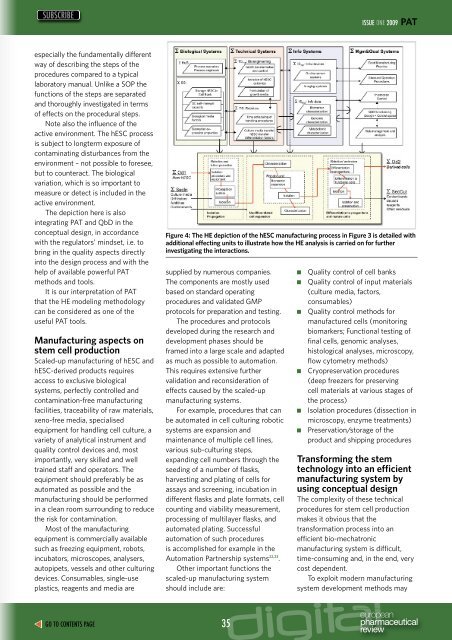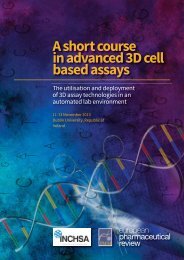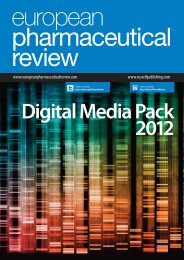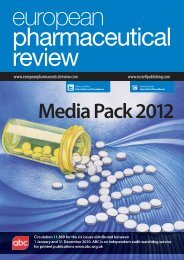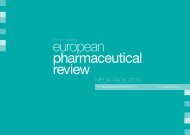Real time PCR - European Pharmaceutical Review
Real time PCR - European Pharmaceutical Review
Real time PCR - European Pharmaceutical Review
Create successful ePaper yourself
Turn your PDF publications into a flip-book with our unique Google optimized e-Paper software.
SUBSCRIBE<br />
ISSUE<br />
2009 PAT<br />
especially the fundamentally different<br />
way of describing the steps of the<br />
procedures compared to a typical<br />
laboratory manual. Unlike a SOP the<br />
functions of the steps are separated<br />
and thoroughly investigated in terms<br />
of effects on the procedural steps.<br />
Note also the influence of the<br />
active environment. The hESC process<br />
is subject to longterm exposure of<br />
contaminating disturbances from the<br />
environment – not possible to foresee,<br />
but to counteract. The biological<br />
variation, which is so important to<br />
measure or detect is included in the<br />
active environment.<br />
The depiction here is also<br />
integrating PAT and QbD in the<br />
conceptual design, in accordance<br />
with the regulators’ mindset, i.e. to<br />
bring in the quality aspects directly<br />
into the design process and with the<br />
help of available powerful PAT<br />
methods and tools.<br />
It is our interpretation of PAT<br />
that the HE modeling methodology<br />
can be considered as one of the<br />
useful PAT tools.<br />
Manufacturing aspects on<br />
stem cell production<br />
Scaled-up manufacturing of hESC and<br />
hESC-derived products requires<br />
access to exclusive biological<br />
systems, perfectly controlled and<br />
contamination-free manufacturing<br />
facilities, traceability of raw materials,<br />
xeno-free media, specialised<br />
equipment for handling cell culture, a<br />
variety of analytical instrument and<br />
quality control devices and, most<br />
importantly, very skilled and well<br />
trained staff and operators. The<br />
equipment should preferably be as<br />
automated as possible and the<br />
manufacturing should be performed<br />
in a clean room surrounding to reduce<br />
the risk for contamination.<br />
Most of the manufacturing<br />
equipment is commercially available<br />
such as freezing equipment, robots,<br />
incubators, microscopes, analysers,<br />
autopipets, vessels and other culturing<br />
devices. Consumables, single-use<br />
plastics, reagents and media are<br />
Figure 4: The HE depiction of the hESC manufacturing process in Figure 3 is detailed with<br />
additional effecting units to illustrate how the HE analysis is carried on for further<br />
investigating the interactions.<br />
supplied by numerous companies.<br />
The components are mostly used<br />
based on standard operating<br />
procedures and validated GMP<br />
protocols for preparation and testing.<br />
The procedures and protocols<br />
developed during the research and<br />
development phases should be<br />
framed into a large scale and adapted<br />
as much as possible to automation.<br />
This requires extensive further<br />
validation and reconsideration of<br />
effects caused by the scaled-up<br />
manufacturing systems.<br />
For example, procedures that can<br />
be automated in cell culturing robotic<br />
systems are expansion and<br />
maintenance of multiple cell lines,<br />
various sub-culturing steps,<br />
expanding cell numbers through the<br />
seeding of a number of flasks,<br />
harvesting and plating of cells for<br />
assays and screening, incubation in<br />
different flasks and plate formats, cell<br />
counting and viability measurement,<br />
processing of multilayer flasks, and<br />
automated plating. Successful<br />
automation of such procedures<br />
is accomplished for example in the<br />
Automation Partnership systems 22,23 .<br />
Other important functions the<br />
scaled-up manufacturing system<br />
should include are:<br />
■<br />
■<br />
■<br />
■<br />
■<br />
■<br />
Quality control of cell banks<br />
Quality control of input materials<br />
(culture media, factors,<br />
consumables)<br />
Quality control methods for<br />
manufactured cells (monitoring<br />
biomarkers; Functional testing of<br />
final cells, genomic analyses,<br />
histological analyses, microscopy,<br />
flow cytometry methods)<br />
Cryopreservation procedures<br />
(deep freezers for preserving<br />
cell materials at various stages of<br />
the process)<br />
Isolation procedures (dissection in<br />
microscopy, enzyme treatments)<br />
Preservation/storage of the<br />
product and shipping procedures<br />
Transforming the stem<br />
technology into an efficient<br />
manufacturing system by<br />
using conceptual design<br />
The complexity of these technical<br />
procedures for stem cell production<br />
makes it obvious that the<br />
transformation process into an<br />
efficient bio-mechatronic<br />
manufacturing system is difficult,<br />
<strong>time</strong>-consuming and, in the end, very<br />
cost dependent.<br />
To exploit modern manufacturing<br />
system development methods may<br />
GO TO CONTENTS PAGE 35


